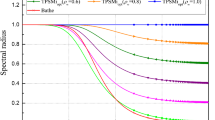Abstract
The precise time step integration method proposed for linear time-invariant homogeneous dynamic systems can provide precise numerical results that approach an exact solution at the integration points. However, difficulty arises when the algorithm is used for non-homogeneous dynamic systems, due to the inverse matrix calculation and the simulation accuracy of the applied loading. By combining the Gaussian quadrature method and state space theory with the calculation technique of matrix exponential function in the precise time step integration method, a new modified precise time step integration method (e.g., an algorithm with an arbitrary order of accuracy) is proposed. In the new method, no inverse matrix calculation or simulation of the applied loading is needed, and the computing efficiency is improved. In particular, the proposed method is independent of the quality of the matrix H. If the matrix H is singular or nearly singular, the advantage of the method is remarkable. The numerical stability of the proposed algorithm is discussed and a numerical example is given to demonstrate the validity and efficiency of the algorithm.
Similar content being viewed by others
References
Argyris JH, Vaz LE and Willam K J (1977), “Higher Order Methods for Transient Diffusion Analysis,” Computer Methods in Applied Mechanics and Engineering, 12: 243 -278.
Bathe KJ and Wilson EL (1976), “Numerical Methods in Finite Element Analysis,” Prentice-Hall, Inc., Englewood Cliffs, N.J
Chang Chunxin (1988), “Fundementals of Modern Control Theory,” China Mechanical Industry Press, Beijing. (in Chinese)
Gellert M (1978), “A New Algorithm for Integration of Dynamic Systems,” Computers and Structures, 9: 401–408.
Golley BW (1996), “A Time-stepping Procedure for Structural Dynamics Using Gaussian Point Collocation,” International Journal for Numerical Methods in Engineering, 39: 3985–3998.
Gu YX, Chen BS and Zhang HW (2000), “Precise Time-integration with Dimension Expanding Method,” Acta Mechanica Sinica, 32(4): 447–456. (in Chinese)
Kujawski J and Gallagher RH (1989), “A Generalized Least-squares Family of Algorithms for Transient Dynamic Analysis,” Earthquake Engineering and Structural Dynamics, 18: 539–550.
Lin Jiahao, Shen Weiping and Williams FW (1995), “A High Precision Direct Integration Scheme for Structures Subjected to Transient Dynamic Loading,” Computer Structures, 56(1): 113–120.
Riff R and Baruch M (1984), “Time Finite Element Discretization of Hamilton, Law of Varying Action,” AIAA Journal, 22: 1310–1318.
Tarnow N and Simo JC (1994), “How to Render Second Order Accurate Time Stepping Algorithms Fourth Order Accurate While Retaining the Stability and Conservation Properties,” Computer Methods in Applied Mechanics and Engineering, 115: 233–252.
Wang M F and Au FTK (2004), “Higher-order Schemes for Time Integration in Dynamic Structural Analysis,” Journal of sound and vibration, 278: 690–698.
Zhong W X. and Williams F W (1994), “A Precise Time Step Integration Method,” Proceedings of Institution of Mechanical Engineers, Part C: Journal of Mechanical Engineering Science, 208: 427–430.
Author information
Authors and Affiliations
Corresponding author
Rights and permissions
About this article
Cite this article
Wang, M., Zhou, X. Modified precise time step integration method of structural dynamic analysis. Earthq. Engin. Engin. Vib. 4, 287–293 (2005). https://doi.org/10.1007/s11803-005-0011-1
Received:
Accepted:
Issue Date:
DOI: https://doi.org/10.1007/s11803-005-0011-1




